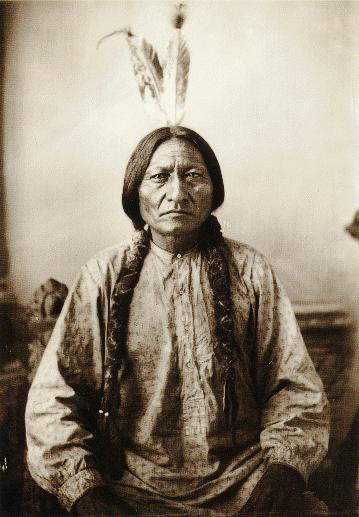Native Americans
The only nonimmigrant ethnic group in the United States, Native Americans once numbered in the millions but by 2010 made up only 0.9 percent of U.S. populace; see above (U.S. Census 2010). Currently, about 2.9 million people identify themselves as Native American alone, while an additional 2.3 million identify them as Native American mixed with another ethnic group (Norris, Vines, and Hoeffel 2012).
Sports Teams with Native American Names


The sports world abounds with team names like the Indians, the Warriors, the Braves, and even the Savages and Redskins. These names arise from historically prejudiced views of Native Americans as fierce, brave, and strong savages: attributes that would be beneficial to a sports team, but are not necessarily beneficial to people in the United States who should be seen as more than just fierce savages.
Since the civil rights movement of the 1960s, the National Congress of American Indians (NCAI) has been campaigning against the use of such mascots, asserting that the “warrior savage myth . . . reinforces the racist view that Indians are uncivilized and uneducated and it has been used to justify policies of forced assimilation and destruction of Indian culture” (NCAI Resolution #TUL-05-087 2005). The campaign has met with only limited success. While some teams have changed their names, hundreds of professional, college, and K–12 school teams still have names derived from this stereotype. Another group, American Indian Cultural Support (AICS), is especially concerned with the use of such names at K–12 schools, influencing children when they should be gaining a fuller and more realistic understanding of Native Americans than such stereotypes supply.
What do you think about such names? Should they be allowed or banned? What argument would a symbolic interactionist make on this topic?
How and Why They Came
The earliest immigrants to America arrived millennia before European immigrants. Dates of the migration are debated with estimates ranging from between 45,000 and 12,000 BCE. It is thought that early Indians migrated to this new land in search of big game to hunt, which they found in huge herds of grazing herbivores in the Americas. Over the centuries and then the millennia, Native American culture blossomed into an intricate web of hundreds of interconnected tribes, each with its own customs, traditions, languages, and religions.
History of Intergroup Relations
Native American culture prior to European settlement is referred to as Pre-Columbian: that is, prior to the coming of Christopher Columbus in 1492. Mistakenly believing that he had landed in the East Indies, Columbus named the indigenous people “Indians,” a name that has persisted for centuries despite being a geographical misnomer and one used to blanket 500 distinct groups who each have their own languages and traditions.
The history of intergroup relations between European colonists and Native Americans is a brutal one. As discussed in the section on genocide, the effect of European settlement of the Americans was to nearly destroy the indigenous population. And although Native Americans’ lack of immunity to European diseases caused the most deaths, overt mistreatment of Native Americans by Europeans was devastating as well.
From the first Spanish colonists to the French, English, and Dutch who followed, European settlers took what land they wanted and expanded across the continent at will. If indigenous people tried to retain their stewardship of the land, Europeans fought them off with superior weapons. A key element of this issue is the indigenous view of land and land ownership. Most tribes considered the earth a living entity whose resources they were stewards of, the concepts of land ownership and conquest didn’t exist in Native American society. Europeans’ domination of the Americas was indeed a conquest; one scholar points out that Native Americans are the only minority group in the United States whose subordination occurred purely through conquest by the dominant group (Marger 1993).
After the establishment of the United States government, discrimination against Native Americans was codified and formalized in a series of laws intended to subjugate them and keep them from gaining any power. Some of the most impactful laws are as follows:
- The Indian Removal Act of 1830 forced the relocation of any native tribes east of the Mississippi River to lands west of the river.
- The Indian Appropriation Acts funded further removals and declared that no Indian tribe could be recognized as an independent nation, tribe, or power with which the U.S. government would have to make treaties. This made it even easier for the U.S. government to take land it wanted.
- The Dawes Act of 1887 reversed the policy of isolating Native Americans on reservations, instead forcing them onto individual properties that were intermingled with white settlers, thereby reducing their capacity for power as a group.
Native American culture was further eroded by the establishment of Indian boarding schools in the late nineteenth century. These schools, run by both Christian missionaries and the United States government, had the express purpose of “civilizing” Native American children and assimilating them into white society. The boarding schools were located off-reservation to ensure that children were separated from their families and culture. Schools forced children to cut their hair, speak English, and practice Christianity. Physical and sexual abuses were rampant for decades; only in 1987 did the Bureau of Indian Affairs issue a policy on sexual abuse in boarding schools. Some scholars argue that many of the problems that Native Americans face today result from almost a century of mistreatment at these boarding schools.
Current Status
The eradication of Native American culture continued until the 1960s, when Native Americans were able to participate in and benefit from the civil rights movement. The Indian Civil Rights Act of 1968 guaranteed Indian tribes most of the rights of the United States Bill of Rights. New laws like the Indian Self-Determination Act of 1975 and the Education Assistance Act of the same year recognized tribal governments and gave them more power. Indian boarding schools have dwindled to only a few, and Native American cultural groups are striving to preserve and maintain old traditions to keep them from being lost forever.
However, Native Americans (some of whom now wished to be called American Indians so as to avoid the “savage” connotations of the term “native”) still suffer the effects of centuries of degradation. Long-term poverty, inadequate education, cultural dislocation, and high rates of unemployment contribute to Native American populations falling to the bottom of the economic spectrum. Native Americans also suffer disproportionately with lower life expectancies than most groups in the United States.